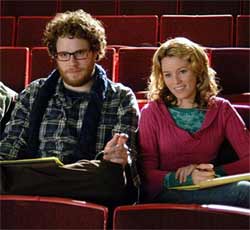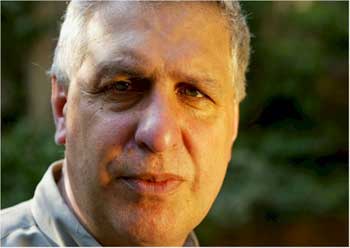 Kevin Smith’s forthcoming film, Zack and Miri Make a Porno, is, at least for the moment, rated NC-17 “for some graphic sexuality,” pending appeal. What is exceedingly frustrating here is that the MPAA, true to its character, isn’t being transparent about what this “graphic sexuality” entails. Last month, Seth Rogan spilled some details to the press, reporting that the skirmish between Smith and the MPAA apparently involves a sex scene between a man and a woman. And while News Askew reports that the MPAA is now reassessing the current cut of the film for an appeal, there’s been nothing specific about the situation on Kevin Smith’s blog.
Kevin Smith’s forthcoming film, Zack and Miri Make a Porno, is, at least for the moment, rated NC-17 “for some graphic sexuality,” pending appeal. What is exceedingly frustrating here is that the MPAA, true to its character, isn’t being transparent about what this “graphic sexuality” entails. Last month, Seth Rogan spilled some details to the press, reporting that the skirmish between Smith and the MPAA apparently involves a sex scene between a man and a woman. And while News Askew reports that the MPAA is now reassessing the current cut of the film for an appeal, there’s been nothing specific about the situation on Kevin Smith’s blog.
The MPAA has gone after Smith before, most notably for Clerks, which was originally slapped with an NC-17 rating merely for its raunchy dialogue. But there’s a larger question here about why the MPAA continues to maintain an antediluvian attitude on “decency.” The young audience who will watch this film will likely get their hands on the unedited version (assuming Smith loses this battle) once it hits DVD. But if Smith were to unload the specifics about his situation, going to the press with the same highly detailed fervor that he has before, he could very well reopen the very important debate on why incredibly violent films like Hostel are slapped with an R, while films featuring the naked human body are considered verboten for the shopping mall crowd. But if he can skirt around the appeal, this may not be an issue.

 Correspondent: I wanted to ask you about music in your films. It’s certainly important in American Pop. You pilfered from your record collection for that, as well as the “Maybelline” sequence in Heavy Traffic. And there’s “Ah’m a Niggerman” from Coonskin, which you wrote. I’m wondering if you did this because you have an aversion to Carl Stalling-style orchestral music.
Correspondent: I wanted to ask you about music in your films. It’s certainly important in American Pop. You pilfered from your record collection for that, as well as the “Maybelline” sequence in Heavy Traffic. And there’s “Ah’m a Niggerman” from Coonskin, which you wrote. I’m wondering if you did this because you have an aversion to Carl Stalling-style orchestral music.
 Correspondent: I actually want to bring up
Correspondent: I actually want to bring up